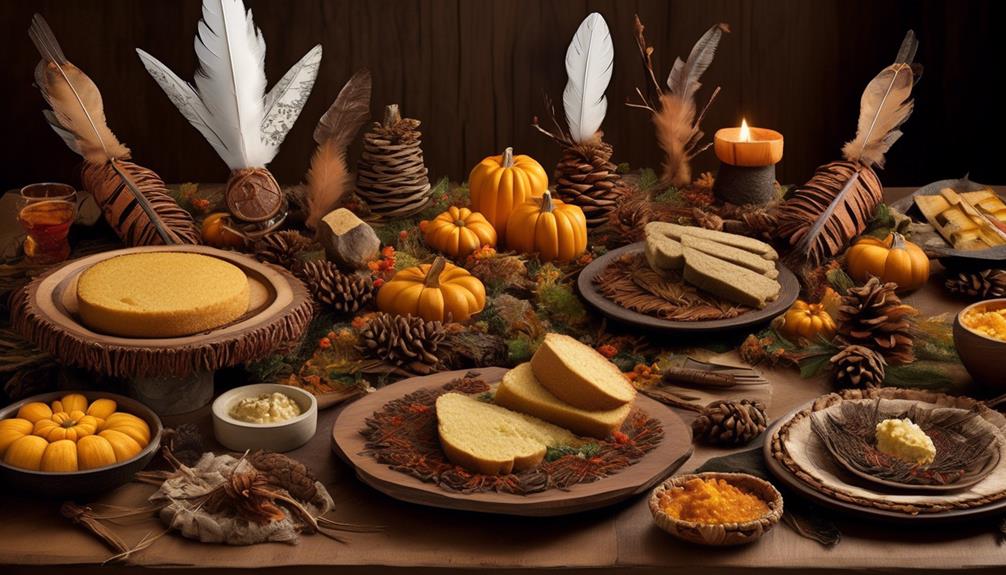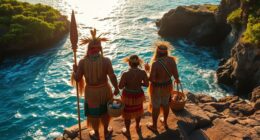We understand that celebrating Thanksgiving in a traditional indigenous manner may seem unfamiliar or daunting to some.
However, as we seek to honor and respect the origins of this holiday, it's essential to consider how we can authentically incorporate indigenous traditions and perspectives into our celebrations.
There are meaningful ways to acknowledge and appreciate the indigenous cultures and histories that are often overlooked during this time of year.
By embracing indigenous foods, learning from their perspectives, and honoring their traditions, we can create a more inclusive and respectful Thanksgiving experience for all.
Key Takeaways
- Embrace Indigenous foods and recipes to diversify culinary experiences and honor rich traditions.
- Learn from Indigenous perspectives by actively engaging with Indigenous communities, attending cultural events, and participating in educational programs.
- Honor Indigenous traditions and rituals in a meaningful and respectful manner, engaging in activities that reflect customs and participating in community gatherings.
- Support Indigenous communities by seeking out and prioritizing Indigenous voices, supporting grassroots initiatives and organizations, encouraging economic self-sufficiency, and advocating for fair labor practices.
History and Significance of Thanksgiving
The history and significance of Thanksgiving lie in the tradition of coming together to express gratitude and to commemorate the early interactions between Native American tribes and European settlers.
Thanksgiving has its origins in the harvest festivals celebrated by various Native American tribes. These festivals were a way of giving thanks for the bounty of the land and the community's well-being. The cultural significance of these early celebrations is immense, as they represent a deep connection to the land and a sense of communal gratitude.
When European settlers arrived, they brought with them their own traditions of giving thanks for a successful harvest. The interaction between the Native American tribes and the European settlers led to the sharing of customs and traditions, which eventually culminated in the Thanksgiving holiday as we know it today.
Understanding the origins and cultural significance of Thanksgiving allows us to appreciate the diverse roots of this holiday and the importance of coming together in gratitude. It serves as a reminder of the historical interactions between different cultures and the values of thankfulness and community that transcend time and place.
Embracing Indigenous Foods and Recipes

Indigenous foods and recipes offer a rich tapestry of flavors and traditions that connect us to the land and the history of the people who have nurtured them. Embracing Indigenous ingredients is a beautiful way to honor the cultural appreciation and rich heritage of Indigenous communities. By incorporating these ingredients into our Thanksgiving meals, we not only diversify our culinary experiences but also pay homage to the roots of this holiday.
| Indigenous Ingredients | Cultural Significance | Traditional Dishes |
|---|---|---|
| Wild Rice | Sacred grain to many Indigenous cultures | Wild rice stuffing, soups, and casseroles |
| Bison | Symbol of strength and survival | Bison stew, roasted bison, and bison jerky |
| Maize (Corn) | Staple crop with deep spiritual and cultural significance | Cornbread, succotash, and hominy |
These Indigenous ingredients reflect the deep connection to the land and the sustainable practices of Indigenous peoples. By incorporating them into our Thanksgiving celebrations, we honor and respect the rich traditions that have been passed down through generations. This act of cultural appreciation fosters a sense of unity and understanding, making our Thanksgiving table a true reflection of diversity and inclusivity.
Learning From Indigenous Perspectives
How can we actively engage with and learn from the diverse perspectives of Indigenous communities in order to enrich our understanding and appreciation of their heritage?
Learning from Indigenous perspectives is crucial in developing a more comprehensive cultural understanding. Engaging with Indigenous communities in a respectful and open manner allows us to gain insights that can significantly broaden our worldview.
One way to achieve this is by actively seeking out opportunities to listen to and learn from Indigenous voices. This can be done through attending cultural events, reading literature by Indigenous authors, and participating in educational programs focused on Indigenous history and traditions.
Furthermore, building relationships with Indigenous community members can provide a deeper understanding of their perspectives. By fostering these connections, we can benefit from the wisdom, knowledge, and experiences that Indigenous individuals and communities have to offer.
It's also essential to approach this learning process with humility and a willingness to unlearn and relearn. This involves acknowledging and addressing any biases or misconceptions we may hold and being open to embracing new ways of thinking and being.
Honoring Indigenous Traditions and Rituals

As we continue our exploration of Indigenous perspectives, it's important to honor their traditions and rituals in a meaningful and respectful manner. Traditional practices are deeply rooted in Indigenous cultures and hold significant value in cultural preservation. When celebrating heritage, it's essential to engage in activities that reflect the customs and rituals of the Indigenous communities. This can include participating in traditional ceremonies, storytelling, or engaging in crafts and arts that have been passed down through generations.
Community gatherings play a vital role in honoring Indigenous traditions. These gatherings provide a space for sharing knowledge, fostering a sense of belonging, and strengthening cultural identity. It's important to approach these gatherings with an open mind, respect, and a willingness to learn. When participating, consider the significance of each ritual and its role in the community's history and values.
Supporting Indigenous Communities
One effective way to support Indigenous communities is by actively seeking out and prioritizing their voices in decision-making processes that affect their land and resources. By doing so, we can ensure that their perspectives, traditional knowledge, and rights are respected and upheld.
In addition to this crucial step, there are other meaningful ways to support Indigenous communities:
- Community Empowerment
- Supporting grassroots initiatives and organizations that are led by Indigenous people. This could involve providing financial assistance, volunteering time and skills, or amplifying their causes through social and traditional media.
- Encouraging and participating in initiatives that promote economic self-sufficiency within Indigenous communities, such as supporting Indigenous-owned businesses and advocating for fair labor practices.
Frequently Asked Questions
How Can Non-Indigenous Individuals Respectfully Participate in Indigenous Thanksgiving Celebrations?
We believe that cultural sensitivity and inclusivity are crucial when participating in Indigenous Thanksgiving celebrations.
It's important to approach these events with appreciation and respect for the traditions and customs of the Indigenous communities.
Non-Indigenous individuals can respectfully participate by showing genuine interest, learning about the significance of the celebration, and honoring the traditions of the host community.
In doing so, we can create an atmosphere of mutual understanding and respect.
Are There Any Specific Protocols or Etiquette to Follow When Attending an Indigenous Thanksgiving Gathering?
When attending an Indigenous Thanksgiving gathering, it's essential to be mindful of respectful participation and cultural protocols. Understanding and honoring the traditions and customs of the community is crucial.
We should approach the event with an open heart and a willingness to listen and learn. It's important to seek guidance from the hosts and elders, showing appreciation for their knowledge and leadership.
Embracing humility and demonstrating genuine interest in understanding their practices is key.
What Are Some Ways to Support Indigenous Communities Beyond Thanksgiving Celebrations?
Supporting Indigenous Communities goes beyond Thanksgiving.
Understanding and respecting their cultures is vital.
We can start by educating ourselves on Indigenous history and current issues.
Supporting Indigenous businesses and artists, amplifying their voices, and advocating for their rights are also crucial.
It's about being allies in their struggles and celebrating their resilience.
Let's ensure our support extends beyond celebrations, fostering real change and empowerment for Indigenous communities.
What Are Some Common Misconceptions About Indigenous Thanksgiving Traditions That Should Be Avoided?
Common misconceptions about Indigenous Thanksgiving traditions should be avoided to ensure respectful participation in Thanksgiving celebrations.
It's important to understand that Indigenous traditions vary across different tribes and communities. Avoid generalizing and assuming that all Indigenous peoples have the same customs.
Instead, take the time to learn about specific traditions and histories, and approach Thanksgiving celebrations with cultural sensitivity and inclusivity.
Are There Any Specific Ways to Incorporate Indigenous Languages and Customs Into Thanksgiving Celebrations?
Incorporating indigenous languages and traditional customs into Thanksgiving celebrations is crucial for cultural sensitivity and respectful participation. By learning and using indigenous languages, we honor and preserve the rich linguistic heritage of indigenous communities.
Embracing traditional customs, such as storytelling, drumming, or dancing, can enrich the holiday experience and foster a deeper understanding of indigenous cultures. It's essential to approach these practices with humility and respect, recognizing their significance and meaning.
Conclusion
As we gather to celebrate Thanksgiving, let's remember to honor the diverse traditions and wisdom of Indigenous peoples.
Let's feast on the flavors of their ancestral foods and listen to their stories with open hearts.
In doing so, we can weave a richer tapestry of gratitude and understanding, embracing the true spirit of this holiday.
Together, let's acknowledge and uplift the voices and experiences of Indigenous communities, creating a more compassionate and inclusive world for generations to come.









